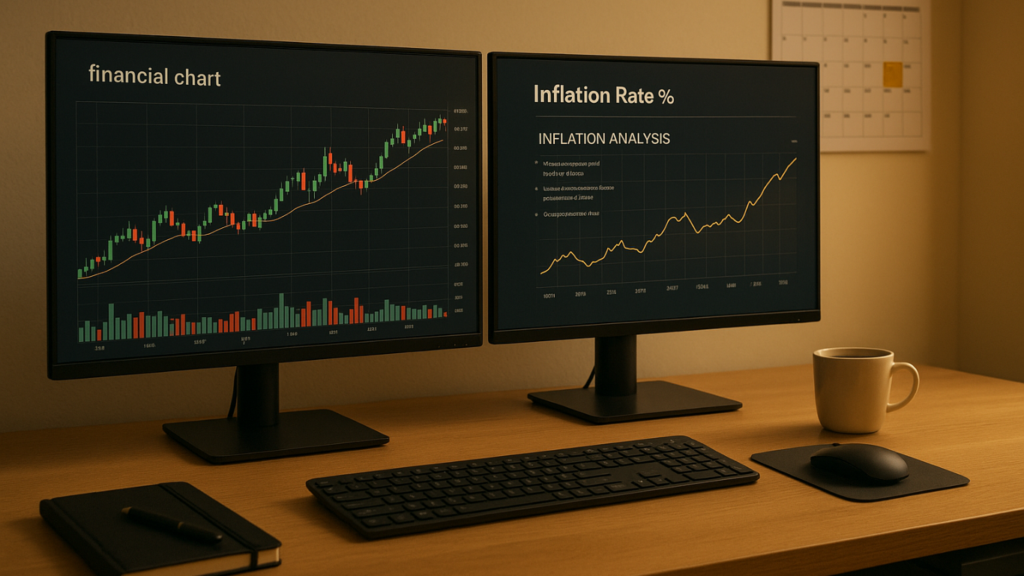Inflation reports can cause sudden market movements, creating both opportunities and risks for traders. In Singapore, these reports hold extra weight due to the Monetary Authority of Singapore’s (MAS) unique focus on managing the SGD’s exchange rate instead of interest rates. This makes inflation data from major economies, like the US, highly relevant, often impacting SGD volatility and local markets.
To trade effectively during these high-impact events, preparation and discipline are key. Here’s a quick summary of what you need to know:
- Before the release: Check economic calendars for release dates, study past data, and identify key price levels on charts.
- During the release: Avoid impulsive trades. Let the market settle and follow your trading system’s pre-set rules. Use trusted data sources like MAS or SingStat.
- After the release: Review how actual data compared to expectations, evaluate your trades, and refine your strategy for the future.
For Singapore traders, understanding MAS policies, global inflation trends, and timing trades around SGD’s reaction to major data releases is essential. Success lies in sticking to a structured plan, managing risk, and learning from each trading session.
How Inflation Reports Affect Markets
What Are Inflation Reports?
Inflation reports measure how prices change over time, offering insights into the health of an economy. The Consumer Price Index (CPI) is the most common gauge, tracking the cost of a basket of everyday goods and services like food, housing, transport, and healthcare. For a clearer picture of long-term trends, core inflation – which excludes more volatile items like food and energy – is often used.
These reports are typically released monthly in major economies. In Singapore, the Department of Statistics publishes CPI data around the 23rd of each month. Over in the US, CPI figures are released mid-month, often sparking notable market reactions.
Central banks rely heavily on inflation data to shape monetary policies. If inflation runs too high, they may tighten policies to cool things down. Conversely, if inflation is too low, they might take steps to stimulate the economy. This makes inflation reports a vital tool for predicting central bank decisions.
How Inflation Data Moves Markets
Inflation reports have a direct impact on market behaviour. Currency markets, for instance, react almost instantly. Higher-than-expected inflation often strengthens a currency, as traders anticipate interest rate hikes. On the flip side, lower inflation can signal potential rate cuts, weakening the currency.
In Singapore, the Monetary Authority of Singapore (MAS) uses a currency basket system to manage the Singapore dollar (SGD). When inflation pressures rise, the MAS may adjust the SGD’s trading band. For example, if US CPI data surprises on the upside, the SGD often strengthens against the USD as traders expect tighter monetary conditions.
Equity markets, however, have mixed responses. Moderate inflation can be seen as a sign of economic growth, which benefits stocks. But when inflation climbs too high, it can hurt corporate profits and reduce consumer spending. For instance, the Straits Times Index (STI) has been known to drop following unexpected US inflation reports, as Singapore’s export-driven economy faces challenges from potential US interest rate hikes.
Bond markets tend to move inversely to inflation expectations. Rising inflation erodes the value of fixed payments, leading to a drop in bond prices. While Singapore Government Securities follow this trend, the impact is generally less dramatic compared to US Treasuries.
Commodities often shine during inflationary periods, as they act as a hedge against rising prices. Gold, oil, and agricultural products tend to rally when inflation data comes in hot. This can sometimes boost Singapore-listed commodity stocks like Wilmar International.
These global reactions create unique dynamics in Singapore’s financial markets.
Singapore Market Factors
Singapore’s highly open economy makes it particularly sensitive to global inflation trends. Imported goods contribute significantly to local price pressures, and the SGD’s value often fluctuates in response to these changes.
The MAS’s exchange rate policy plays a crucial role here. When global inflation rises, the MAS may allow the SGD to appreciate. This can help lower the cost of imports and ease domestic inflationary pressures.
Trade relationships also magnify the impact of inflation. For example, Singapore’s strong trade ties with China mean that Chinese inflation data can heavily influence local markets. Meanwhile, US inflation affects Singapore through direct trade, financial markets, and the USD’s role in global commodity pricing.
Timing also matters. US CPI data is typically released at 21:30 SGT, after local markets have closed. This often causes overnight price gaps in SGX-listed stocks, especially for companies with US market exposure, such as Singapore Airlines or DBS Bank.
Inflation surprises can also trigger sector-specific shifts. For instance, REITs often underperform when rate hike expectations rise, while banks may initially benefit. However, if inflation dampens overall economic growth, banks could eventually feel the pinch. Export-focused companies face a double-edged sword: a stronger SGD can hurt competitiveness, even as global demand slows.
Understanding these local and global factors highlights the importance of a well-thought-out trading strategy during inflation-driven market events.
Before the Release: Preparation Steps
Check Economic Calendars
Timing matters when trading inflation reports. Start by consulting official release calendars like those from MAS, SingStat, Investing.com, or Trading Economics. These sources help you pinpoint the exact dates and times of key inflation reports.
Don’t stop there – compare consensus estimates with past figures. Even a small change, like a 0.1% difference, can lead to noticeable shifts in the SGD.
Study Key Price Levels and Risk
Once you’ve confirmed the release schedule, shift focus to market technicals to manage your risk effectively. Take a close look at daily, weekly, and monthly charts to pinpoint support and resistance levels. Trendlines (with at least three touches) and moving averages can highlight dynamic price levels. Remember, a broken support level often turns into resistance, and the reverse is true as well.
During the Release: Trading Actions
Watch Market Reactions
Once the inflation data is released, the market’s initial response can be unpredictable. Prices often swing sharply within the first 5–15 minutes, making it crucial to observe rather than act impulsively. These early reactions are often based on surface-level interpretations and can reverse once traders digest the full implications of the data.
For instance, a seemingly positive inflation reading might initially boost the SGD, but the rally could fade as the market reassesses what the data means for the Monetary Authority of Singapore’s (MAS) monetary policy. Instead of chasing price movements, wait for your trading system to confirm the market’s direction. Whether you’re using moving average crossovers, candlestick patterns, or momentum indicators, stick to your pre-established signals even in the face of erratic price changes. Once the market direction becomes clearer, verify it with accurate and reliable data.
Use Reliable Data Sources
In trading, speed is important, but accuracy is critical. For Singapore-specific inflation data, rely on trusted sources like MAS releases and the Department of Statistics Singapore (SingStat). These official outlets provide the most accurate and authoritative figures, reducing the risk of acting on preliminary or incorrect information.
If you’re trading SGD pairs influenced by global inflation reports, monitor updates from sources like the US Bureau of Labor Statistics for American CPI data, Eurostat for European statistics, and the Bank of Japan for Japanese inflation metrics. Platforms like Bloomberg Terminal and Reuters also offer real-time feeds that can help you stay ahead.
Avoid relying on social media or trading chat rooms for breaking news. By the time information reaches these platforms, the market often has already reacted. Always cross-check any surprising or unusual figures with official sources before making trading decisions. Once the data is verified, follow your trading system’s rules without deviation.
Follow Your Trading System
This is where discipline becomes your most valuable asset. The rules you set for entry and exit before the release are designed to guide you through volatile moments like these, where emotions can cloud judgement.
For example, if your system requires a breakout above resistance with volume confirmation, stick to those criteria. Similarly, respect your stop-loss levels even if the market becomes highly volatile due to news. Consistency is key – structured, rule-based trading helps prevent the common mistake of abandoning your plan during high-impact events.
To manage risk during these volatile periods, consider reducing your position size by 25–50%. This adjustment allows you to navigate the uncertainty while still participating in the market. A smaller position size can also help you maintain a clear head and stick to your plan, even when the market feels chaotic.
Master Systematic Trading with Collin Seow
Learn proven trading strategies, improve your market timing, and achieve financial success with our expert-led courses and resources.
After the Release: Review and Adjust
Once the storm of market volatility calms, it’s time to shift gears. This is your opportunity to evaluate your performance and fine-tune your approach for the next round.
Compare Actual vs Expected Data
Start by comparing the actual inflation numbers with what was anticipated. This step helps you gauge how accurate your predictions were and offers insights to sharpen your future decisions.
Take a close look at how the market reacted right after the release versus how it settled by the session’s close. Pay special attention to how the SGD moved against major currencies like the USD, EUR, or JPY. Document these patterns – it’s like building your own playbook for understanding how inflation data influences currency movements.
Don’t overlook the size of the deviation between actual and expected figures. While small differences might barely nudge the market, larger gaps can send shockwaves through it. Over time, tracking these relationships will give you a better sense of what qualifies as a market-moving event. This kind of analysis doesn’t just help you understand short-term reactions; it’s also a powerful tool for shaping your long-term strategy.
Review Your Trades
Next, dive into a review of your trades. What worked? What didn’t? Keep a detailed record of key trade details – this will help you spot patterns and identify areas for improvement.
Tailor your performance analysis to your trading style. If you’re a day trader, looking at “open-to-close” performance might make sense. Swing traders, on the other hand, could benefit from analysing “previous-close-to-close” results. Don’t just focus on the wins – study your losing trades too. They often hold the most valuable lessons.
Look for recurring patterns in your decision-making. For instance, you might notice a habit of exiting profitable trades too early during volatile periods or taking on excessive risk when major economic data is released. Recognising these tendencies is the first step to addressing them.
Update Your Strategy
Finally, use what you’ve learned to refine your trading strategy. If you find consistent mismatches between your market expectations and actual outcomes, it’s time to reassess. Consider whether factors like global economic trends or Monetary Authority of Singapore policy expectations are influencing your analysis.
Tighten up your risk management rules based on your review. Replace vague goals like “be cautious with risk” with specific, actionable steps. For example, set clear criteria for position sizing or establish conditions for entering trades after periods of high volatility. These adjustments will strengthen your trading framework and help you maintain discipline, even in unpredictable market conditions.
Regularly updating your strategy ensures it stays relevant to shifting market dynamics. This ongoing refinement is crucial for building a systematic and consistent approach, which is the backbone of long-term trading success.
Singapore Trader Considerations
Understanding the local and global dynamics at play is essential for crafting a trading strategy that aligns with inflation reports.
MAS Policy Effects on SGD
The Monetary Authority of Singapore (MAS) manages the Singapore dollar (SGD) through a trade-weighted exchange rate system. When inflation surpasses expectations, MAS may adjust its policy band, potentially strengthening the SGD. Keep an eye on the semi-annual policy statements released in April and October for clues about these adjustments.
For example, if core inflation rises beyond forecasts, the SGD could gain strength. This scenario might prompt traders to diversify their positions across key currency pairs to manage risk effectively.
Timing is another critical factor. The SGD often reacts more sharply during periods of peak activity by local financial institutions, making it important to align trades with these windows for better outcomes.
Global Inflation Impact on Singapore
Global inflation trends, like the release of US Consumer Price Index (CPI) data, play a significant role in shaping Singapore’s inflation expectations and market movements. These global shifts, along with changes in commodity prices, directly influence local sentiment and trading strategies.
For instance, the Straits Times Index (STI) often reflects shifts in market sentiment tied to global inflation data. Financial stocks may respond to anticipated adjustments in MAS policy or interest rate expectations, while REITs and property-related stocks tend to show increased sensitivity as investors reassess asset valuations.
Singapore’s strategic time zone also gives traders a unique advantage. US inflation data is typically released at 9:30 PM SGT, providing traders with the overnight period to evaluate global market reactions. This allows for more calculated decisions before the Asian trading session begins.
To dive deeper into strategies for managing market volatility during inflation report releases, check out the resources available at Collin Seow Trading Academy.
Conclusion
A solid trading plan is your best ally when navigating the volatility that comes with inflation reports. Trading during these times requires preparation, disciplined execution, and a thorough review afterwards. A good approach includes marking your calendar for key events, identifying critical price levels, and sticking to stringent risk management rules – all while following your trading plan.
For traders in Singapore, understanding the Monetary Authority of Singapore’s (MAS) policies and keeping an eye on global inflation trends is especially important. Singapore’s strategic time zone offers an edge, enabling traders to make well-informed decisions before the Asian trading session kicks off.
The secret to trading during inflation reports lies in eliminating emotional decision-making. As the Systematic Trader Program by Collin Seow Trading Academy puts it:
“A system that simply works and aims to take all emotions out of your trades. Make profitable trades regardless of market direction”.
Structured learning replaces impulsive actions with disciplined, methodical strategies, allowing traders to act with clarity and consistency.
At Collin Seow Trading Academy, the systematic approach focuses on key aspects of trading during volatile periods: selecting the right instruments, timing entries and exits with precision, and managing position sizes based on your risk tolerance. Whether you’re gearing up for the next inflation report or refining your broader trading strategy, adopting these techniques can help you trade with greater confidence and consistency during high-stakes market events.
FAQs
Why is it important for traders in Singapore to understand global inflation trends?
Understanding global inflation trends is crucial for traders in Singapore because it directly affects currency values, interest rates, and market volatility. For example, when global inflation rises, the US dollar often gains strength. This can impact Singapore’s export competitiveness and may shape decisions around local monetary policies.
The Monetary Authority of Singapore (MAS) keeps a close eye on inflation figures to fine-tune exchange rate policies and ensure economic stability. By staying updated on these trends, traders can better predict policy shifts, mitigate risks, and take advantage of opportunities during periods of increased market activity.
What should traders watch to understand how the SGD might respond to inflation reports?
To navigate the market effectively, traders should pay attention to critical indicators like the Consumer Price Index (CPI), core inflation trends, and commodity price movements. These elements are essential for understanding inflationary pressures and their potential impact on the Singapore Dollar (SGD).
It’s also important to track global inflation signals and how markets respond to inflation data from major economies. By staying alert during inflation report releases, traders can better anticipate changes in the value of the SGD and make more informed choices, even in a volatile market.
Why should traders avoid impulsive decisions during initial market reactions to inflation reports, and how can they prepare for the volatility?
Traders should steer clear of making snap decisions during the immediate aftermath of inflation reports. This period is often marked by sharp price fluctuations and unpredictable market movements, which can easily lead to costly errors or substantial losses.
A smarter approach is to stay disciplined and allow the market to stabilise – usually about 5 to 10 minutes after the report is released – before taking any action. Having a solid trading plan with clear risk management strategies in place is key. This helps traders avoid emotional reactions and focus on confirmed market trends instead of getting caught up in short-term volatility. By sticking to this method, traders can aim for more consistent and well-informed results.












